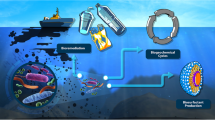Abstract
Several bacteria from soil and rainwater samples were enriched and isolated with propanesulfonate or butanesulfonate as sole carbon and energy source. Most of the strains isolated utilized nonsubstituted alkanesulfonates with a chain length of C3–C6 and the substituted sulfonates taurine and isethionate as carbon and energy source. A gram-positive isolate, P40, and a gram-negative isolate, P53, were characterized in more detail. Phylogenetic analysis grouped strain P40 within group IV of the genus Rhodococcus and showed a close relationship with Rhodococcus opacus. After phylogenetic and physiological analyses, strain P53 was identified as Comamonas acidovorans. Both bacteria also utilized a wide range of sulfonates as sulfur source. Strain P40, but not strain P53, released sulfite into the medium during dissimilation of sulfonated compounds. Cell-free extracts of strain P53 exhibited high sulfite oxidase activity [2.34 U (mg protein)–1] when assayed with ferricyanide, but not with cytochrome c. Experiments with whole-cell suspensions of both strains showed that the ability to dissimilate 1-propanesulfonate was specifically induced during growth on this substrate and was not present in cells grown on propanol, isethionate or taurine. Whole-cell suspensions of both strains accumulated acetone when oxidizing the non-growth substrate 2-propanesulfonate. Strain P40 cells also accumulated sulfite under these conditions. Stoichiometric measurements with 2-propanesulfonate as substrate in oxygen electrode experiments indicate that the nonsubstituted alkanesulfonates were degraded by a monooxygenase. When strain P53 grew with nonsubstituted alkanesulfonates as carbon and energy source, cells expressed high amounts of yellow pigments, supporting the proposition that an oxygenase containing iron sulfur centres or flavins was involved in their degradation.
Similar content being viewed by others
Author information
Authors and Affiliations
Additional information
Received: 21 December 1998 / Accepted: 18 March 1999
Rights and permissions
About this article
Cite this article
Reichenbecher, W., Murrell, J. Linear alkanesulfonates as carbon and energy sources for gram-positive and gram-negative bacteria. Arch Microbiol 171, 430–438 (1999). https://doi.org/10.1007/s002030050730
Issue Date:
DOI: https://doi.org/10.1007/s002030050730




